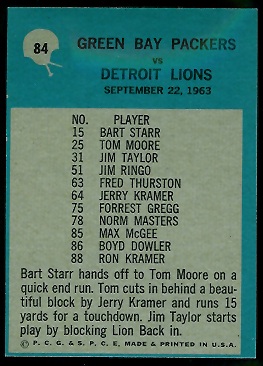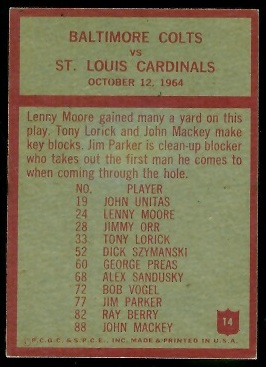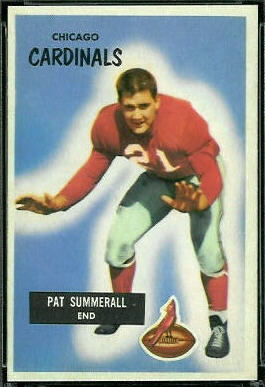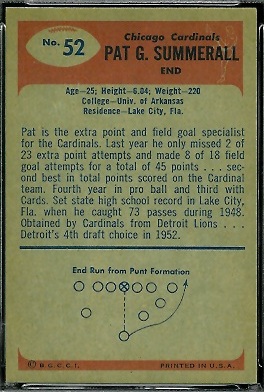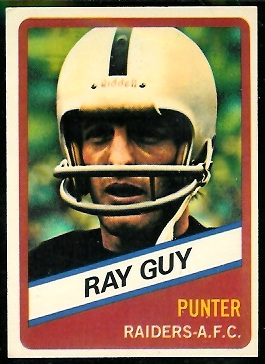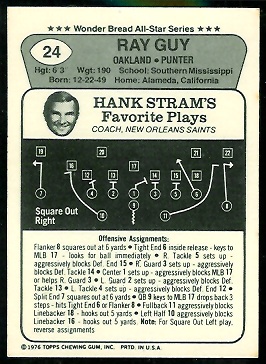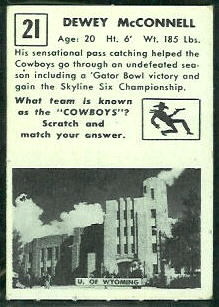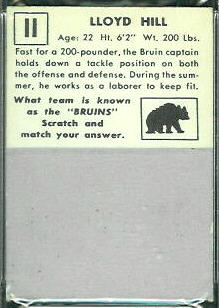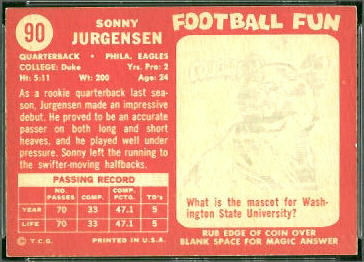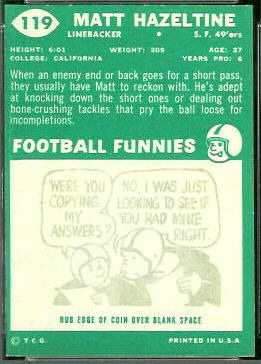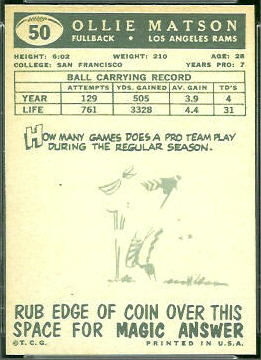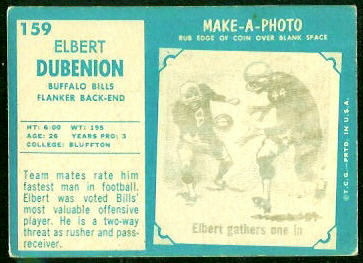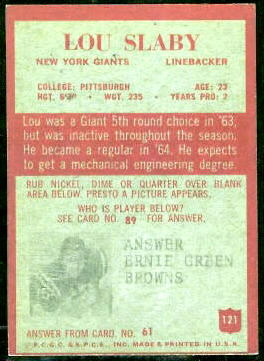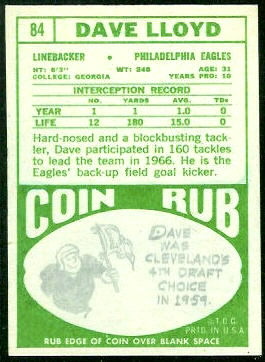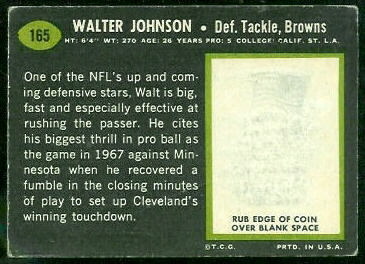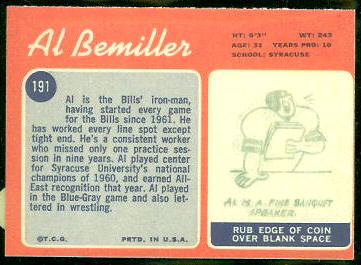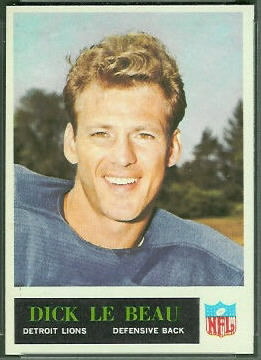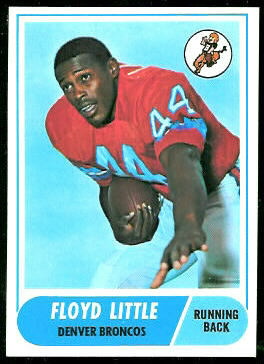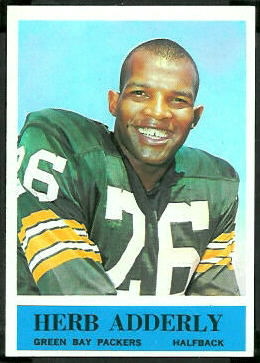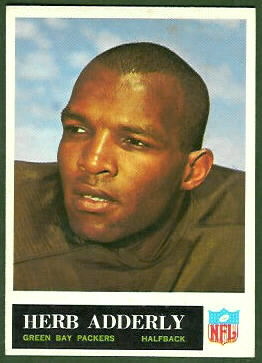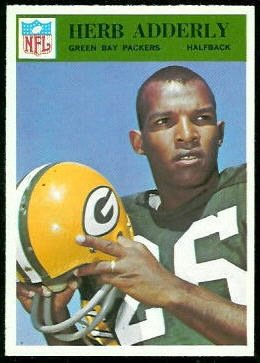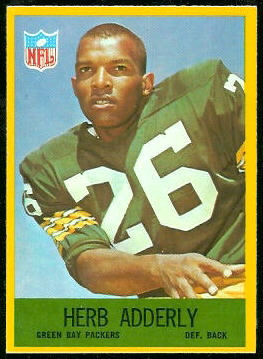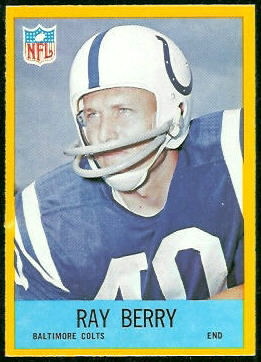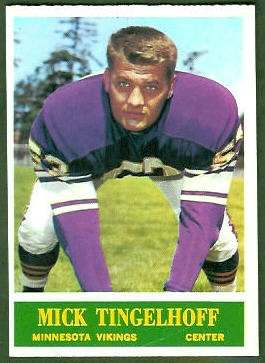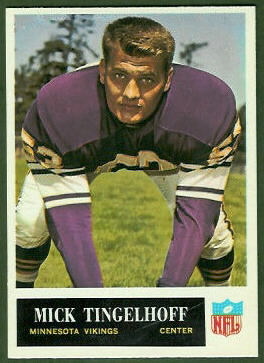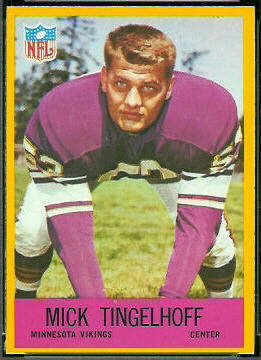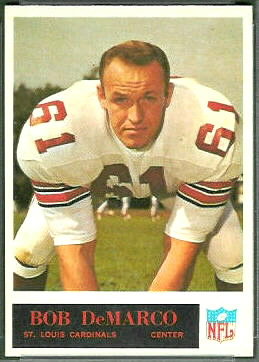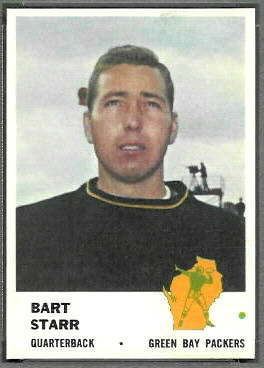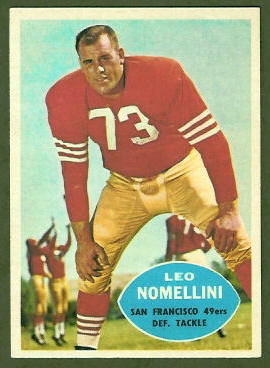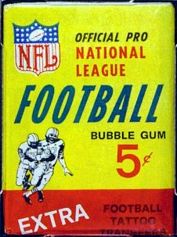 The Philadelphia Gum Company printed football cards from 1964 to 1967. For those four years, Philadelphia had the rights to NFL players, and Topps had the rights to AFL players. The contrast between the companies’ products is striking: the Topps sets of those years are colorful and varied, and the Philadelphia sets are simple and conservative.
The Philadelphia Gum Company printed football cards from 1964 to 1967. For those four years, Philadelphia had the rights to NFL players, and Topps had the rights to AFL players. The contrast between the companies’ products is striking: the Topps sets of those years are colorful and varied, and the Philadelphia sets are simple and conservative.
All four of the Philadelphia sets are similar. Each of them has 198 cards, grouped by team, and the last two cards in each set are checklists. The teams are ordered alphabetically by city, with Baltimore first in 1964 and 1965 and Atlanta first in 1966 and 1967. Each set contains a team photo card for each team.
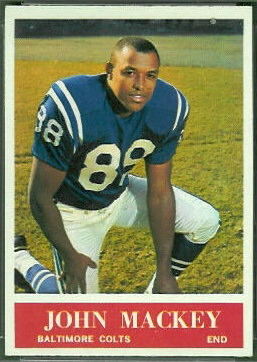 I find the 1964 Philadelphia set to be the most attractive of the four, because the colored nameplates with the white borders around them make the cards brighter than the other years. Most of the 1964 cards are easy to find in high grade, though, and that takes some of the fun out of it. A few cards–the checklists come to mind–are challenging because of centering. (See C is for Checklists.)
I find the 1964 Philadelphia set to be the most attractive of the four, because the colored nameplates with the white borders around them make the cards brighter than the other years. Most of the 1964 cards are easy to find in high grade, though, and that takes some of the fun out of it. A few cards–the checklists come to mind–are challenging because of centering. (See C is for Checklists.)
The Play of the Year cards are the plainest in the 1964 set, and in truth they feature some pretty ordinary plays. They do include photos of the coaches, though, and among the coaches are Vince Lombardi and Don Shula, who had not appeared on cards before. My Beckett catalog does not recognize the Lombardi and Shula cards as their rookie cards, but I don’t know why. The back of each Play of the Year card also lists the offensive players involved in the play. Some of these players never appeared on cards of their own, but at least their names appear here in print.
The 1964 Philly set includes the rookie cards of five Hall of Fame players–Herb Adderley, John Mackey, Willie Davis, Jim Johnson, and Merlin Olsen. Philadelphia misspelled Adderley’s name on his card, and they misspelled it the next three years, too. Other bits of 1964 Philadelphia trivia are that Jim Brown’s Cadillac appears in the background on all of the Browns’ cards, and that the player pictured on Garland Boyette’s card is actually Don Gillis.
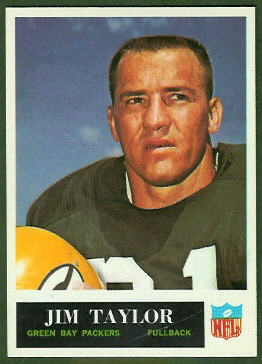 1965 Philadelphia is the dullest of the four sets. It has essentially the same composition as the 1964 set–single-player cards, team cards, play cards, and checklists–but it has little color because the nameplates have a black background. Most of the players even look unhappy.
1965 Philadelphia is the dullest of the four sets. It has essentially the same composition as the 1964 set–single-player cards, team cards, play cards, and checklists–but it has little color because the nameplates have a black background. Most of the players even look unhappy.
The one bit of innovation in the set is the “Who Am I?” rub-off quiz on the card backs. Oddly, rubbing the card reveals a player’s picture and the answer for a different card, so you have to rub one card to get the question and rub another card to get the answer. Also, my friend Steve from thecowboysguide.com said that not all of the rub-offs work. In Steve’s words, “You’ll get some duds because of age and condition.”
On a positive note, the set holds the rookie cards of five Hall of Fame players: Paul Warfield, Mel Renfro, Paul Krause, Carl Eller, and Charley Taylor. And Renfro is actually smiling!
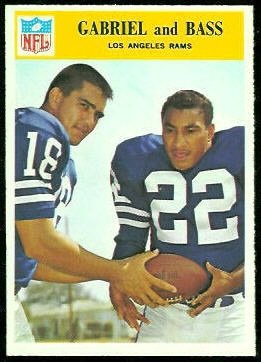 Perhaps collectors noticed that the 1965 set was dull, because the next year Philadelphia shook things up a bit. The 1966 Philadelphia set returned to colored nameplates, for play cards it had action photos instead of X-and-O diagrams, and it even had two cards–Morrall and Scholtz and Gabriel and Bass–with two players on them. The set also gave the Atlanta Falcons a proper introduction. Since the Falcons were new to the league, the card company could not include an action card for them from the year before, so instead they included a Falcons insignia card. The insignia was big and bold, and it happened to be the first card in the set.
Perhaps collectors noticed that the 1965 set was dull, because the next year Philadelphia shook things up a bit. The 1966 Philadelphia set returned to colored nameplates, for play cards it had action photos instead of X-and-O diagrams, and it even had two cards–Morrall and Scholtz and Gabriel and Bass–with two players on them. The set also gave the Atlanta Falcons a proper introduction. Since the Falcons were new to the league, the card company could not include an action card for them from the year before, so instead they included a Falcons insignia card. The insignia was big and bold, and it happened to be the first card in the set.
One thing I noticed about the 1966 action photos is that they were all shot in New York and Los Angeles. As a result, the action cards picture a lot of Giants and Rams defensive players. Each of the action cards has a referee signal on the back, and card #196 is dedicated to referee signals. Compared to Topps’s cards, which had cartoons and fun facts on the back, Philadelphia’s cards were all business.
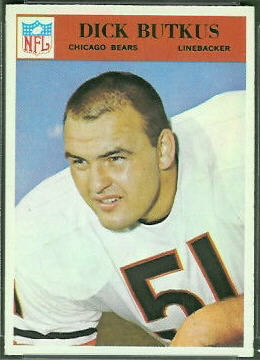 The 1966 Philadelphia set is much tougher than its predecessors to complete in high grade. While some cards are plentiful, others are scarce, and I suspect that a lot of them are undocumented short prints. I found a picture of an uncut sheet that suggests why. For a 198-card set, I would expect there to be three 132-card sheets, with each sheet containing two-thirds of the set. Between the three sheets, there would then be two of each card. The sheet I found, though, contains 110 of the 198 cards, and the top two rows are repeated. There had to be at least another sheet that held the remaining 88 cards, but I can’t think of how a small number of additional sheets could have been configured to even out the distribution of cards. Rows 3 through 6 on the sheet I found contain some of the tough cards in the set, so I’ll wager that those rows did not appear on another sheet.
The 1966 Philadelphia set is much tougher than its predecessors to complete in high grade. While some cards are plentiful, others are scarce, and I suspect that a lot of them are undocumented short prints. I found a picture of an uncut sheet that suggests why. For a 198-card set, I would expect there to be three 132-card sheets, with each sheet containing two-thirds of the set. Between the three sheets, there would then be two of each card. The sheet I found, though, contains 110 of the 198 cards, and the top two rows are repeated. There had to be at least another sheet that held the remaining 88 cards, but I can’t think of how a small number of additional sheets could have been configured to even out the distribution of cards. Rows 3 through 6 on the sheet I found contain some of the tough cards in the set, so I’ll wager that those rows did not appear on another sheet.
Like the two earlier Philadelphia sets, the 1966 set contains the rookie cards of five Hall of Fame players. Six years ago it contained only two, Gale Sayers and Dick Butkus. The other three–Bob Brown, Gene Hickerson, and Bob Hayes, have all been inducted in the past five years.
For more details on the 1966 Philadelphia set, you can read Jim Churilla’s article on the PSA web site.
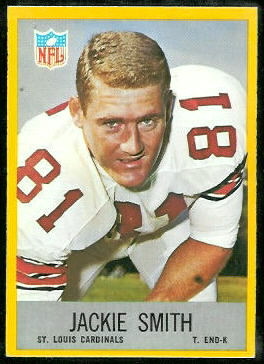 In 1967, Philadelphia printed their last set of football cards. Like the 1966 set, it has a funky distribution: some cards are plentiful in high grades, and some are downright scarce. The company got a bit less conservative in 1967, coloring the borders yellow and adding colorful cards of the team insignias. 1967 was the year that New Orleans joined the NFL, so a bit more color was fitting.
In 1967, Philadelphia printed their last set of football cards. Like the 1966 set, it has a funky distribution: some cards are plentiful in high grades, and some are downright scarce. The company got a bit less conservative in 1967, coloring the borders yellow and adding colorful cards of the team insignias. 1967 was the year that New Orleans joined the NFL, so a bit more color was fitting.
Two bits of trivia are worth mentioning: Raymond Berry’s 1967 Philadelphia card actually pictures Bob Boyd, and Paul Hornung appears on a Saints card, but he retired before the start of the season. The 1967 Philly set contains three rookie cards of Hall of Fame players: Leroy Kelly, Jackie Smith, and Dave Wilcox.
Though I’m sure it wasn’t intentional, it seems that in the Philadelphia years, the Philadelphia and Topps issues reflected the images of the leagues they represented. The Philly sets were conservative, consistent, and unadorned. The 1964-1967 Topps sets were colorful and innovative, with stars and tall boys and TVs. Philadelphia had the talent, and Topps had the flash. Philadelphia’s run was too short to draw conclusions, but by 1967 it seems as though Topps was prompting Philadelphia to lighten up, just as the AFL was pressuring the NFL to enliven its game.
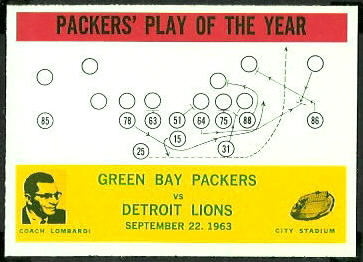
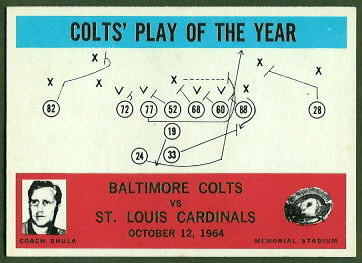 The 1964 and 1965 Philadelphia sets include a “Play of the Year” card for each team. On the front of each card is a diagram of the play and a small image of the team’s head coach. The small images are a nice touch, I suppose, but I would have preferred dedicated cards with full-size images for the coaches.
The 1964 and 1965 Philadelphia sets include a “Play of the Year” card for each team. On the front of each card is a diagram of the play and a small image of the team’s head coach. The small images are a nice touch, I suppose, but I would have preferred dedicated cards with full-size images for the coaches.